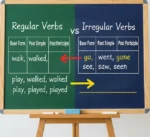What are the “Irregular Third-Person singular Verbs” Anyway?
Hello, English learners! Today, we’re going to tackle a common challenge: irregular verbs in the third-person singular. You’ve probably learned the basic rule: for “he,” “she,” and “it,” we usually add “-s,” “-es,” or “-ies” to the verb. But guess what? English loves its exceptions! Don’t worry, we’ll break it down with lots of examples, clear explanations, and even some pictures to help you remember.
What’s the “Third-Person Singular” Anyway?
Before we dive into irregular verbs, let’s quickly review what “third-person singular” means. For a complete guide to the main rules, see our comprehensive article: Third Person Singular – Add S ES IES to verbs
- Person: This refers to who is doing the action.
- First Person: I, We
- Second Person: You
- Third Person: He, She, It, They
- Number: This refers to how many.
- Singular: One (I, You, He, She, It)
- Plural: More than one (We, You, They)
So, third-person singular means “he,” “she,” or “it” (or any noun that can be replaced by “he,” “she,” or “it,” like “John,” “Sarah,” “the dog”).
The Regular Rule: A Quick Refresh
For most verbs, when the subject is “he,” “she,” or “it,” we add an “-s,” “-es,” or “-ies.”
- Add -s: Most verbs (e.g., walks, sings, reads)
- Add -es: Verbs ending in -s, -ss, -sh, -ch, -x, -o, -z (e.g., goes, washes, watches, fixes, kisses)
- Add -ies: Verbs ending in a consonant + -y (change -y to -i and add -es) (e.g., studies, cries, flies)
Here’s a little chart to help you visualize:
Chart 1: Regular Third-Person Singular Verb Endings
| Rule | Base Verb | He/She/It Form | Example Sentence |
| Add -s | walk | walks | She walks to school. |
| Add -es (ends in -sh) | wash | washes | He washes the dishes. |
| Add -es (ends in -ch) | watch | watches | It watches the birds. |
| Add -es (ends in -o) | go | goes | She goes to work. |
| Change -y to -i, add -es | study | studies | He studies every night. |
The Big Exceptions: Irregular Verbs!
Now, for the exciting part – the verbs that don’t follow these rules! There are a few very common verbs that change their form completely in the third-person singular. These are super important because you’ll use them all the time.
Let’s look at the main ones:
1. The Verb “To Be”
This is perhaps the most irregular and most important verb in English!
- I am
- You are
- He/She/It is (This is the irregular third-person singular form!)
- We are
- They are
Examples:
- She is a doctor.
- He is very tall.
- It is a sunny day.
Chart 2: The Verb “To Be”
| Subject | Verb Form |
| I | am |
| You | are |
| He | is |
| She | is |
| It | is |
| We | are |
| They | are |
2. The Verb “To Have”
Another extremely common irregular verb!
- I have
- You have
- He/She/It has (This is the irregular third-person singular form!)
- We have
- They have
Examples:
- He has a new car.
- She has blue eyes.
- The dog has a long tail.
Chart 3: The Verb “To Have”
| Subject | Verb Form |
| I | have |
| You | have |
| He | has |
| She | has |
| It | has |
| We | have |
| They | have |
3. The Verb “To Do”
While “do” usually ends with “-es” for third-person singular (like “goes”), its base form is so common that it often feels like an irregular exception.
- I do
- You do
- He/She/It does (This is the irregular third-person singular form, notice the ‘o’ becomes ‘oe’ and then ‘-s’ is added)
- We do
- They do
Examples:
- He does his homework every night.
- She does not like coffee. (We use “does” even in negative sentences!)
- It does not matter.
Chart 4: The Verb “To Do”
| Subject | Verb Form |
| I | do |
| You | do |
| He | does |
| She | does |
| It | does |
| We | do |
| They | do |
4. The Verb “To Go”
Similar to “do,” “go” follows the “-es” rule for verbs ending in “-o,” but because it’s so frequently used, it’s worth highlighting as a key verb to remember.
- I go
- You go
- He/She/It goes (This is the third-person singular form!)
- We go
- They go
Examples:
- He goes to the gym.
- She goes shopping on Saturdays.
- The train goes very fast.
Chart 5: The Verb “To Go”
| Subject | Verb Form |
| I | go |
| You | go |
| He | goes |
| She | goes |
| It | goes |
| We | go |
| They | go |
Why Are These Verbs Irregular?
Good question! English is a very old language, and it has borrowed words and rules from many other languages over hundreds of years. The most common verbs (like “to be,” “to have,” “to do”) are often the oldest and have changed their forms in unique ways as the language evolved. Think of them like special, historical words that have kept their old forms!
Memory Tip!
Since these verbs are so common, the best way to learn them is through practice, practice, practice!
- Read English books and articles.
- Listen to English songs and podcasts.
- Speak English with friends or teachers.
- Write sentences using “he,” “she,” and “it” with these verbs.
The more you see and use them, the more natural they will feel!
Here’s an image to help you remember the main irregular verbs visually:

Full Summary Chart: Regular vs. Irregular Third-Person Singular Verbs
This chart puts it all together for you.
| Subject | Regular Verb (e.g., eat) | Irregular Verb to be | Irregular Verb to have | Irregular Verb to do | Irregular Verb to go |
| I | eat | am | have | do | go |
| You | eat | are | have | do | go |
| He | eats | is | has | does | goes |
| She | eats | is | has | does | goes |
| It | eats | is | has | does | goes |
| We | eat | are | have | do | go |
| They | eat | are | have | do | go |
FAQ: Your Questions Answered! – Irregular Third-Person Singular Verbs
Q1: Why are these verbs called “irregular”?
A1: They are called “irregular” because they do not follow the standard rules for adding “-s,” “-es,” or “-ies” in the third-person singular. Their forms change in a unique way.
Q2: Are there other irregular verbs in English?
A2: Yes, many! However, “to be,” “to have,” “to do,” and “to go” are the most common and important ones that are irregular specifically in the third-person singular present tense. Other verbs are “irregular” in their past tense forms (e.g., go -> went, eat -> ate), but that’s a topic for another lesson!
Q3: How can I remember all these exceptions?
A3: The best way is constant exposure and practice. Read, listen, speak, and write in English as much as possible. Make flashcards, do quizzes, or even create your own sentences. Repetition is key!
Q4: Do these irregular verbs affect negative sentences or questions?
A4: Yes, they do!
- To Be: He is not happy. Is she tired?
- To Have: When “have” is a main verb, we use “does” for negatives/questions: He does not have a car. Does she have a cat? (But He has not finished when “have” is an auxiliary verb for perfect tenses).
- To Do: She does not like coffee. Does he like pizza? (Here, “does” is the auxiliary verb).
- To Go: He does not go to the park. Does she go to school?
Q5: Is “got” an irregular form of “to have”?
A5: “Got” is the past participle of “get.” In British English, “have got” is often used to mean “have” (e.g., She has got a cold). This makes it seem complex, but “has” is still the third-person singular form of “to have.” “Got” is part of a phrase.
Additional Helpful Content: Practical Exercises!
Let’s test your understanding! Choose the correct verb form for each sentence.
- She _____ (be) a talented artist.
- He _____ (have) a lot of friends.
- The dog _____ (go) for a walk every morning.
- My sister _____ (do) yoga on Sundays.
- It _____ (be) very cold outside today.
- He _____ (have) a meeting at 10 AM.
- She never _____ (do) her chores.
- The bus _____ (go) to the city center.
Answers: 1. is, 2. has, 3. goes, 4. does, 5. is, 6. has, 7. does, 8. goes
Here is a PDF worksheet you can download to practice Irregular Third-Person Singular Verbs. The answers are on a separate page.
Additional Helpful Links
For a complete guide to the main rules, see our comprehensive article: – Third Person Singular – Add S ES IES to verbs
External Links for Authoritative Sources:
For more detailed information and exercises, you can visit these reputable sources:
- Purdue OWL (Online Writing Lab): https://owl.purdue.edu/owl/general_writing/grammar/verb_tenses/irregular_verbs.html
- British Council LearnEnglish: https://learnenglish.britishcouncil.org/grammar/beginner-to-pre-intermediate/present-simple-he-she-it
- Cambridge Dictionary: (You can search for individual verbs and see their conjugations) https://dictionary.cambridge.org/grammar/british-grammar/verbs/verb-tenses/present-simple
Keep practicing, and you’ll master these irregular verbs in no time! Happy learning!




